Menu
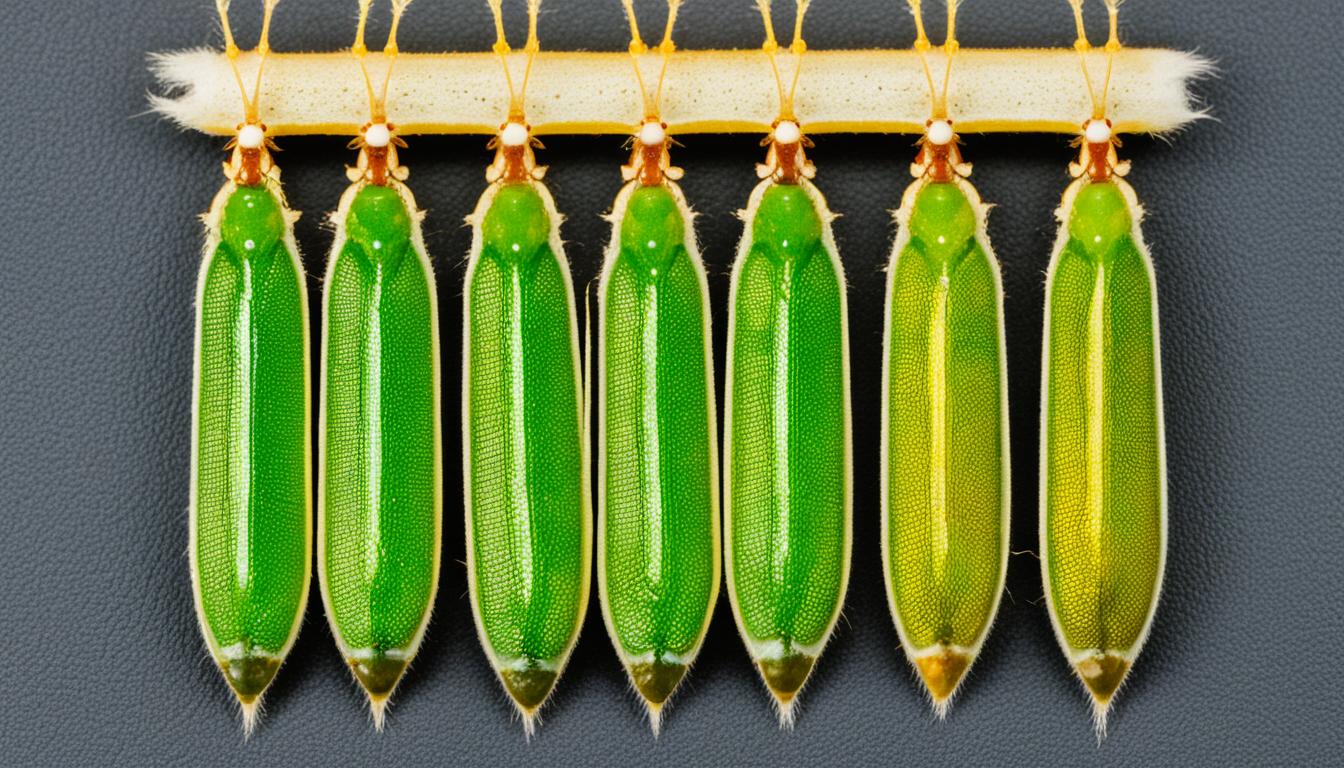
Did you know around 40% of food crops are lost each year to pests and diseases? This big number shows how much trouble pests and diseases cause for our food and the environment. They range from rodents and insects to weeds and tiny organisms that can spread sickness. It’s clear these problems are getting harder to beat with old ways, so we need new plans for looking after our crops.
Dr. Vijay Nandula from the National Institute of Food and Agriculture explains climate change is making this issue worse. It lets pests move to new areas and get stronger, which leads to big losses in crops. They can harm the plants by eating their leaves or spreading diseases.
What can we do against these threats? Well, there are several ways to manage pests. We can stop pests from coming in, change the plants we grow in each field, or even use machines to get rid of them. It’s also a good idea to let their natural enemies, like certain bugs, help keep them in check.
Changing when and how we plant our crops is really helpful too. This can make it harder for pests to find a home. Using machines to turn over the soil a bit can stop new weeds from growing. Also, letting some helpful bugs eat the bad bugs can work very well.
The impact of pests and diseases on agriculture is huge. In 1983, farmers spent $1.3 billion just on pesticides. This shows the severe problem pests cause for crops and income loss.
Crop pests and diseases cut down about 40% of global food crops yearly. This leads to less food and higher prices across the world. For instance, pests can lower bean plant quality so much that crop damage hits between 443 to 452.
Leaf blast can also cause farmers to lose significant portions of their crops, with damage ranging from 357 to 380. This proves we need strong plans to fight these issues, combining accurate simulation modelling.
The danger to food security from pests and diseases is real. They lead to major losses in crops, hitting poor communities hardest. For instance, the wheat productivity in places like the Mediterranean Ebro Valley can drop by 550, affecting many.
Plants have some natural defences against these threats, like over 100 phytoalexins. But breeding resistant plants isn’t always successful because we don’t fully know how some genes work. Also, the focus of research, such as wheat stripe rust, changes over time and with location, causing significant effects, up to 15132.
The fight against pests gets harder as they adapt and become resistant. We need strong, sustainable plans to keep our food safe and reduce the damage pests cause.
Agricultural pests and diseases threaten global food production. They range from insects eating leaves to rodents and birds spreading illnesses. It’s crucial to manage these threats well to protect crop yields. This includes dealing with various crop pests and plant diseases.
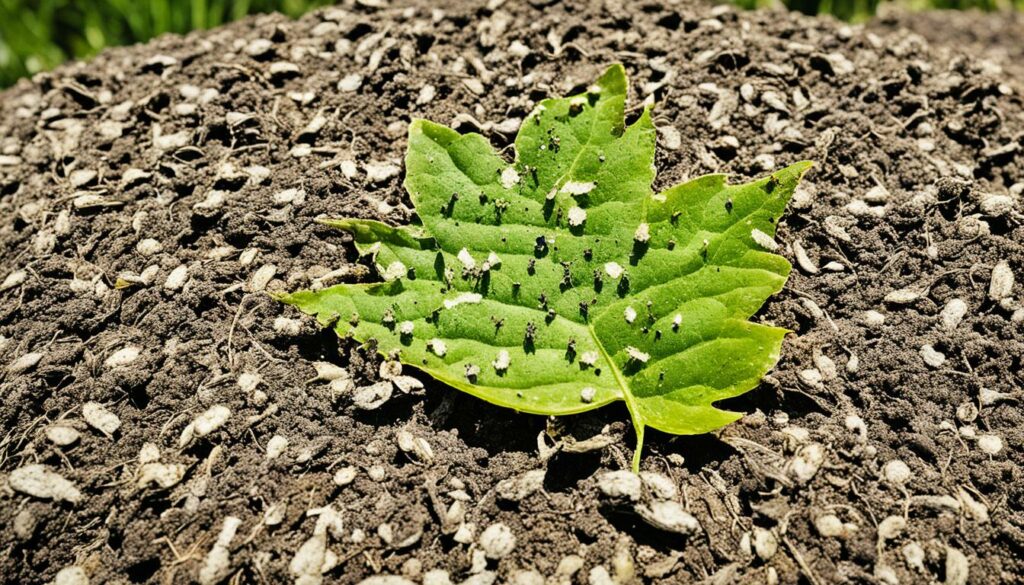
The world of crop pests is vast, from the grey field slug in dense soils to damaging insects. For instance, actively monitoring slug populations with bait traps is crucial. Wireworms with a long life cycle also need careful, long-term attention.
Insects like the wheat bulb fly are big problems, laying their eggs in soil and feeding on crops. It’s important to know when and where these pests strike, so we can intervene at the right time. This helps reduce the damage they cause.
Plant diseases, such as barley yellow dwarf virus and rust, can severely affect crops. They harm the plant’s ability to photosynthesise, which is essential for growth. In the UK, the spread of barley yellow dwarf virus in autumn-sown crops highlights the importance of thorough disease testing.
Managing plant diseases often requires a mix of approaches. By combining disease models and simulators, like in the case of the WARM for rice, we can predict and lessen disease impacts. These strategies are vital for keeping crop productivity sustainable.
To tackle agricultural pests and diseases, we first have to know our enemies. By working together and using advanced models, we can tailor our strategies. These efforts, as shown in studies, are key to long-lasting agricultural success.
Climate change is hugely impacting how pests act. It’s changing where they move and how they grow. This affects our farms and the food we rely on all over the world.
The way pests travel is visibly changing because of climate change. Warmers temperatures make pests move about 3 km more north and south a year. For instance, the southern pine beetle is travelling to new areas and harming forests more.
It’s not just beetles that are moving. The desert locust, for example, can eat as much as 35,000 people in just one day. Also, a fungal disease is suddenly appearing in new places, hurting up to half of the maize harvests there.
Climate change is also altering how often pests come out. It can make pests grow faster, have more babies, or appear more often. This can cause bigger pest problems. An example is wheat rusts, adapting to the heat by making more spores that hurt wheat.
High CO2 levels can change plants, making pests stronger. This happened in the 1840s, affecting millions because of the Irish potato famine. Because of these changes, we have to watch out for pests very carefully and change how we deal with them.
| Pest/Disease | Impact | Adaptation to Climate Change |
|---|---|---|
| Southern Pine Beetle | Forest destruction | Moving northwards in the US and Canada |
| Desert Locusts | Massive crop loss | Migrating over large areas |
| Tar Spot | Up to 50% yield loss in maize | Spreading towards non-tropical regions |
| Wheat Rusts | Increased infestations | Producing larger quantities of spores |
Pesticides have helped a lot in making more food, especially in richer countries. This more nutritious food has made people healthier. But, 40% of the food we grow is still lost to bugs and diseases every year. This shows that depending only on chemicals has its limits and hurts farming.
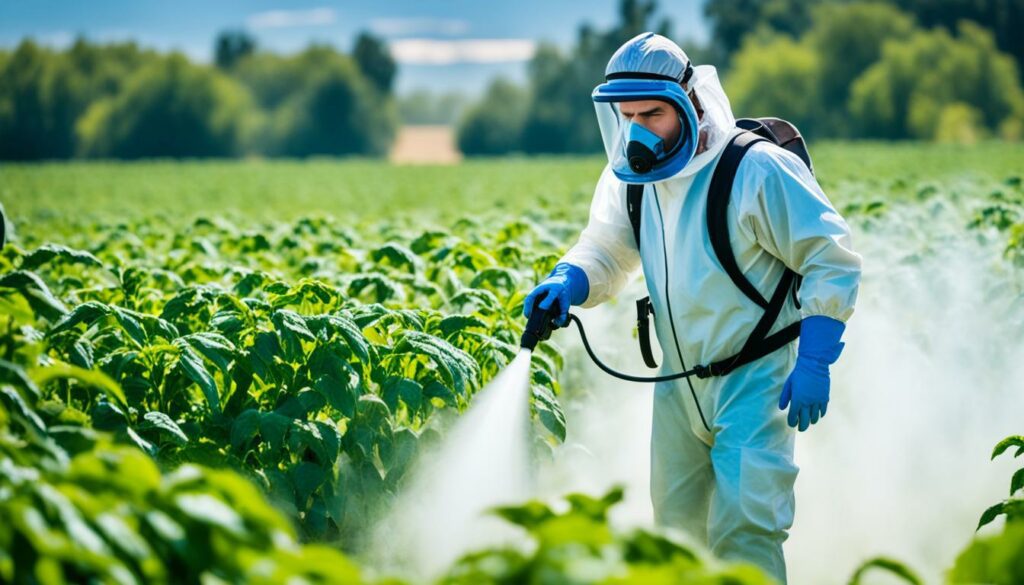
Pesticide use has its big problems though. About 1 million people get sick every year from these poisons. Most of these people are farmers or farm workers who use them a lot. This tells us we need better, less harmful ways to kill pests.
Pesticide resistance is a major issue too. Some pests can now survive the poisons we use. This makes us use more poison more often, and it’s not solving the problem. For a long time, pests becoming resistant to poisons has been growing. Nowadays, more bugs and weeds can ignore the usual pesticides, making them less helpful.
We are working on these problems, though. Integrated pest management and breeding crops that resist diseases are some ways we are trying to tackle these issues. For example, we have the MARPLE Diagnostics lab that can quickly spot plant illnesses. This helps farmers react faster and hopefully prevent big losses. The IPPC is also pushing for cleaner ways to use fumigation, which is less harmful to the environment.
While pesticides have done a lot for farming, their problems are growing. The trouble with them and the resistance issues show us we need new and smarter pest control methods. We must make sure these methods don’t harm people or nature and keep farming strong in the future.
Integrated Pest Management (IPM) is a holistic way to deal with pests. It avoids the risks of using too many chemicals. With IPM, various methods are used to control pests while keeping the environment healthy.
Cultural practices are key in IPM. They involve methods like preparing soil well for strong, pest-resistant plants. Choosing the right planting times and tough plant types help keep pests away. Regular scouting and monitoring early pests can help stop them from spreading.
Using nature’s own insect fighters is a big part of IPM. This can mean introducing predators like ladybirds or using tiny nematodes to control pests. By enabling these friendly pests to thrive, we lower the need for harmful chemicals. This helps keep the ecosystem in balance.
Hands-on pest control methods are also part of IPM. Actions like picking pests off plants or using traps help manage their numbers. Tools and techniques like weed seed removal stop pests from starting in the first place. These ways are kinder to the earth and help avoid pests building a resistance to chemicals.
Crop rotation means changing what type of crop is grown in a field over time. It works by confusing pests and so reduces their harm to the plants. This method also boosts the soil’s health and lowers the need for chemicals.

It’s important to know how diseases spread to beat them. For diseases like barley scald, a quick change in crop type is needed more often than for others. Some diseases leave behind tiny spores that can live in the soil for years. Knowing this helps decide how often to change the plants in a field.
This method is very successful against diseases that can’t survive in the soil for a long time. It means you can see fewer pests after just a few years of using the right crops. This helps crops grow better and cuts down on the need for chemicals.
When and how you plant has a big impact on crop rotation’s success. Doing this right makes the plants stronger against pests. It also helps the soil stay healthy, lowering the risk of disease.
People who work with plants should use these tips. By planting at the right depth and changing the types of plants often, diseases stay away. This means less work, fewer chemicals, and more money for those planting crops.
Biological controls are vital in managing pests in a natural, eco-friendly way without using chemical pesticides. They help protect crops and natural areas from suffering big losses due to pests and diseases. The Biological Control Program by APHIS Plant Protection and Quarantine (PPQ) aims to stop pest spread and manage them using smart methods.’
Natural predators are a key part of biological control. Beetles, ladybugs, and birds can control pests well. APHIS PPQ supports finding and using these predators safely to fight pests.
Another important role of biological controls is saving helpful insects. By changing their living spaces, we boost the numbers of bees, butterflies, and wasps. They help control pests without the need for many chemicals. Universities and other groups work together to study and use these methods. This helps keep the environment healthy.
More people are learning about the harm of pesticides on plants and food. They are choosing biological controls instead. The programme ensures these natural methods are safe and work well. It’s good for the farms, the environment, and the reputation of sustainable farming.’
In the fight against farm pests, tools that don’t use chemicals are growing in popularity. Mechanical methods aim to disturb where pests live and lower their numbers. This way, we lessen damage to the environment and the chance pests will get used to chemical treatments.
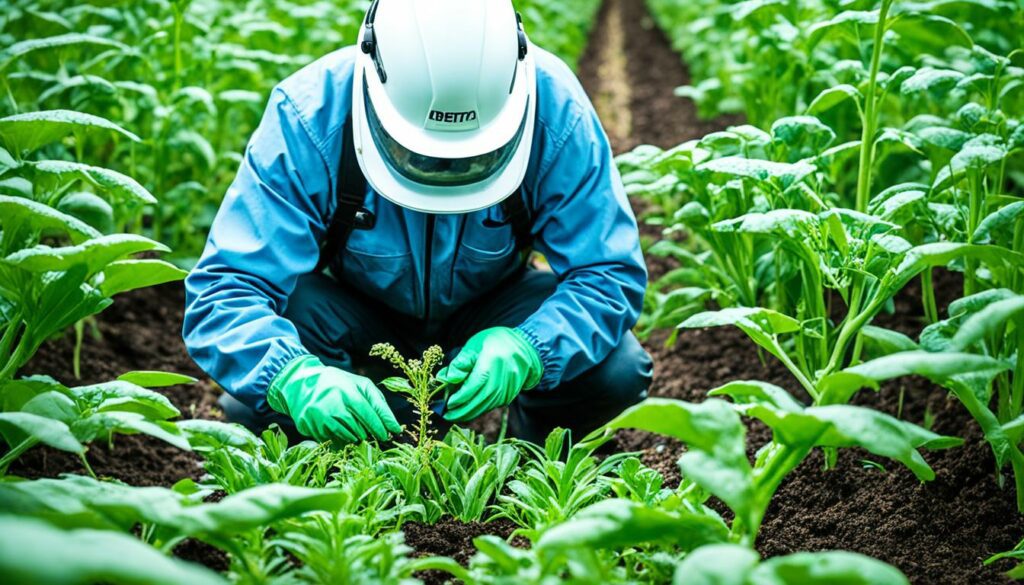
Tillage methods are key in mechanical pest control. They involve turning the soil to break pests’ homes and prevent new ones from growing. This is a great way to fight pests that live in the soil and some plant diseases.
Using your hands to remove pests is simple, cheap, and effective. You can also make or buy traps and attractants easily. This gives everyone, from small gardeners to big farmers, options against pests.
To deal with bug problems, spraying water with force is a good start. But, it’s vital not to harm the plants. Insect vacuums, from small to big machines, are also a hit because they’re efficient.
Diatomaceous earth is another popular choice. This fine powder stops pests coming near plants. It’s used in many ways and is very versatile. On the other hand, insecticidal soaps are great at killing pests without much harm to plants.
Mechanical pest control is shown to work in real farms. The Earth-Kind Gardening Series talks about using new and green ways in farming.
| Technique | Type | Application |
|---|---|---|
| Handpicking | Natural | Manual removal of pests |
| Mechanical Traps | Physical | Homemade or market-purchased traps |
| Water Pressure Sprays | Physical | Usage to dislodge insects cautiously |
| Insect Vacuums | Mechanical | Large tractor-powered or small hand-held devices |
| Diatomaceous Earth | Physical/Repellent | Dusty application to deter pests |
| Insecticidal Soaps | Biological | Contains potassium salt to control pests |
More and more people are turning to nonchemical pest control methods. They offer many advantages over the old chemical ways. These methods, part of Integrated Pest Management (IPM), focus on eco-friendly and lasting solutions. Instead of harming the environment and human health like chemicals can, nonchemicals aim to prevent and manage pests, not destroy them.
Prevention is key in keeping pests away and it’s cheaper, too. This includes things like preparing the soil, picking right plants for where you are, and keeping weeds under control. Also, planting certain crops to lure pests away helps cut down on needing to use chemicals. All these steps keep the ecosystem in check, help crops grow well, and cut down on pests. IPM is becoming more popular with farmers and others because it works well, avoids resistance, and makes pest control last longer.
There are many stories showing that nonchemical ways really do work. Take the example of chaff lining, a technique used for wheat pests. In 2019, a study from Colorado State University found this method effective and cheaper than chemical solutions. Another method, using cover crops and a special way to deal with weed seeds, has been praised for controlling pigweed among soybeans. This study, funded with $325,000 at Iowa State University, showed how good and affordable nonchemical ways can be.
| Institution | Study Focus | Funding | Outcome |
|---|---|---|---|
| Colorado State University | Chaff lining in wheat | $0 | Successful, less expensive |
| Iowa State University | Cover crops and seed control in soybean | $325,000 | Effective seedbank management |
| University of California, Davis | Band steaming in carrot and lettuce | $175,000 | Expanded use of method |
| New Mexico State University | Barley and mustard cover crops | $191,000 | Control of soilborne pathogens |
| Louisiana State University | Image-based predictive modeling | $325,000 | Minimised weed damage |
These cases show the promise and creativity in nonchemical pest control. Information from various studies proves that these methods not only deal with pests now. They also offer a path to feeding and protecting the planet in the future.
Scouting is key in good pest control, keeping fields healthy and safe. Start scouting as soon as crops come up to spot pests early. This cuts the chance of bugs taking over.
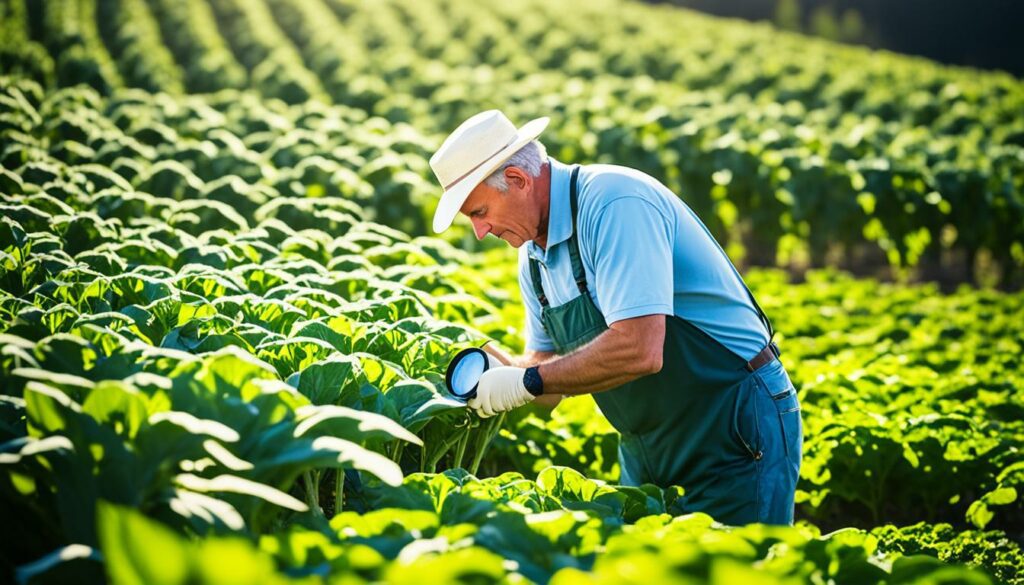
Pests and illnesses are more active in certain seasons, depending on the weather. Regular checks help farmers see problems fast. This way they can deal with issues before they get big.
Using different paths through fields helps spot more insects. Tools like magnifying glasses and white paper catch tiny bugs well. Plus, tech like satellites and drones make scouting even better. They help see the whole picture.
Watching for bugs also means keeping an eye on helpful bugs. These friends help keep nature in balance. Thanks to tech, spotting good bugs is easier. This allows for smart, quick actions.
It’s important to keep detailed notes on what’s found during scouting. This helps know if treatments work and prevent future problems. Good notes mean a plan that stays ahead of bugs.
Scouting often with the latest tools helps protect crops better. It looks after the health and harvest of fields.
New technology is changing how we handle pests in agriculture. With pests and diseases increasing, we need new ways to fight them. By 2050, we’ll need to grow twice as much food because more people will be here. To meet this need, we must use the best tools and methods to protect our crops and make them grow better.
Early warning systems are key in watching out for bugs and plant diseases. They use remote-sensing technologies like satellites and drones to get fast updates on pest problems. By catching issues in large areas from afar, we might cut down on yearly lost grain by 10-16%. In China, using remote-sensing technology has helped save about 40 million tons of grain each year from pests.
Using data to make decisions is vital in pest control today. The Internet of Things (IoT) collects information on crop growth in real-time. With IoT devices powered by the sun, farmers can spot and handle pest risks better. This forward-thinking method improves how we manage pests, reducing the need for chemicals.
| Technology | Application | Impact |
|---|---|---|
| High-altitude remote-sensing | Using satellites | Reduces global grain loss by 10-16% annually |
| Low-altitude remote-sensing | Using drones | Enables timely detection and action |
| IoT Technology | Real-time data collection | Enhances decision-making processes |
| Solar-powered IoT | Energy harvesting | Gradually implemented for sustainability |
Every year, pests and diseases destroy about 40% of food crops. This puts a lot of pressure on using pesticides. However, we can’t overlook the health risks they bring. We need to use pesticides safely and find other ways to control pests.
To apply pesticides safely, we must carefully follow the instructions on the label. It’s also vital to wear the right safety gear. Plus, we should handle, mix, and get rid of pesticides as directed. New agricultural standards are pushing for practices that are safe for the environment and people. For example, the MARPLE Diagnostics lab helps quickly determine if pesticides are needed, making their use safer.
The danger of using pesticides the wrong way can cause long-term health issues for over a million people each year. That’s why educating farmers on safe practices is becoming more important. Also, stricter rules are being put in place to ensure chemicals are handled and disposed of carefully.
| Area | Measure | Outcome |
|---|---|---|
| Proper Use | Following label instructions | Reduced health risks |
| Protective Gear | Using safety equipment | Minimised exposure |
| Storage and Disposal | Safe practices | Environmental protection |
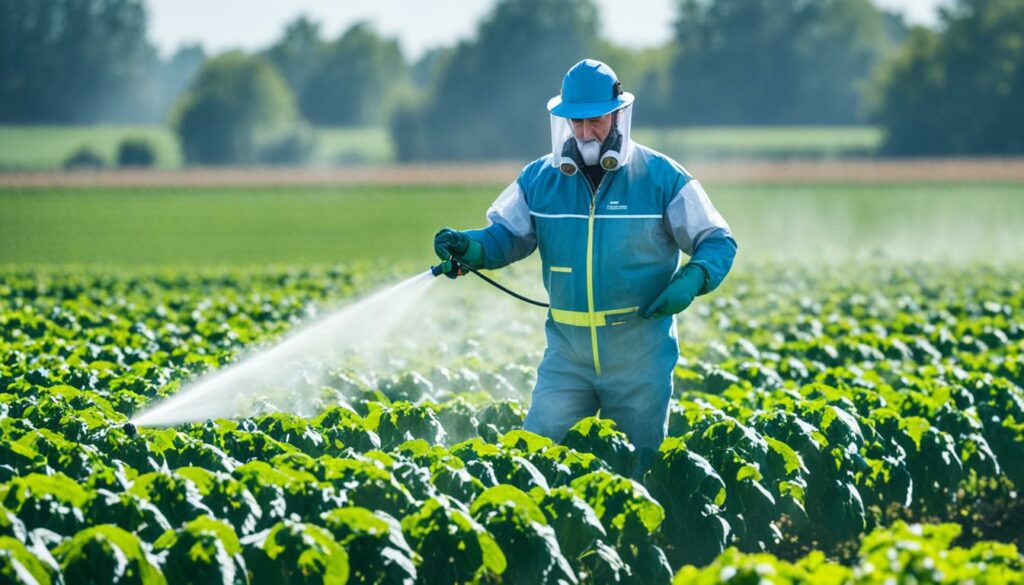
Finding other ways to control pests is key to using fewer chemical pesticides. We can use methods like attracting helpful insects, removing weeds by hand, and setting traps. The changing climate is making pests move to new areas, which requires us to change how we deal with them. Also, high carbon dioxide levels are making plants weaker against pests, needing new pest control ideas.
Worldwide, people are working on ways to control pests that are friendly to the planet. For example, in Vietnam, farmers are assessing their needs to reduce pesticide risks. This activity shows the value of knowing what works and is needed in different places.
“Understanding the health risks pesticides pose is essential for developing safer and more sustainable pest management strategies. Learning from global practices helps in shaping effective solutions that protect human health and the environment.”
Pest management methods’ success can be seen in global case studies. They show how focused efforts can greatly cut down on pest harm. This protects crops and economic activities.
One big win is against the emerald ash borer in the US. This insect is very damaging and costly. It was predicted to cause nearly USD 12.5 billion in losses by 2020. In the Gulf region of the Near East, the red palm weevil causes between USD 5.2 million and 25.9 million damage each year. The fall armyworm, starting in Western Africa, moved fast to damage crops in places like Egypt and India.
From these cases, we learn key farming lessons. One is about pests spreading more due to increased farming and climate change. So, staying alert and adapting are crucial. The use of Fruchtkalk in Bulgaria is a smart pest management method we can learn from. The NEFERTITI project shows that learning from each other is very important.
Also, the work of NAAS and Balkan Bio Frukt with Fruchtkalk offers a model for success. By studying Fruchtkalk and what helps farmers choose these methods, we get better at pest management.
Agricultural pests and diseases lead to big economic losses. About 40% of food crops are lost each year. This hits farm earnings and markets, lowering productivity and causing food shortages globally.
Pests destroy a lot of crops, making food scarce. This hits poor rural areas hard. It makes food shortages worse and makes food supplies unstable.
Crop pests are mainly insects, rodents, and birds. They eat leaves, suck juices, and spread diseases. These diseases can seriously hurt plant health.
Common diseases include blight, mildew, and rust. They can really harm crops and cut how much we can harvest.
Climate change is changing pest patterns and life cycles. Pests move to new areas and change when they are active. This can make it hard to use the usual ways to control them.
Pesticides have helped raise food production and fight diseases. But they can hurt human health and the environment. Pests are also getting better at surviving pesticide use.
IPM uses many methods to control pests in a friendly way. It changes how we farm, uses good bugs, and machines. This prevents pests from getting too strong.
Crop rotation breaks the pest life cycle and their homes. It’s good for the soil and means we can use fewer chemicals. Also, crops become stronger against pests.
Right planting times and seed methods make crops strong against pests. The plants grow in ways that bugs don’t like. This helps crops do better and stay healthier.
Using natural enemies of pests and friendly bugs lowers pesticide use. It keeps the farm in good balance with nature.
Tillage breaks pest homes and seeds, controlling them physically. This protects the land and stops pests from getting too used to our methods.
Nonchemical ways are safer for nature and people. They work better over time, reducing the chance of pests getting too strong and keeping nature in balance.
Checking the farm often helps to spot pests and see helpful bugs at work. Acting early stops pests before they become a big problem. This means we don’t need to use as much harsh control.
Modern farm tech warns us about pests and tells us how to deal with them. This lets us handle pests before they cause big problems. It means we don’t always have to use strong chemicals.
Pesticides can hurt us and the environment. Using them safely and looking for other ways to fight pests can lower these risks.
There are many cases of successful pest control worldwide. They show us the best ways depend on the place and the crops. Using what works for that situation helps a lot.